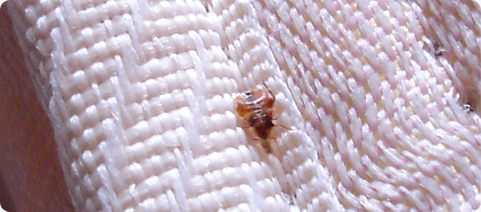Identification of a bed bug infestation

Even though bed bugs are small, about 1/5 of an inch, they can be readily seen with the naked eye. Immature bed bugs, or nymphs, are light yellow in color unless they have recently fed on blood and then they are darker in the middle. After a recent feeding, you can almost see the red color of blood inside. As the blood ages, it darkens and a small quantity of undigested blood is excreted onto surfaces such as bed sheets, mattresses and on other surfaces. Adults are reddish brown and they also turn darker after a blood meal. They are wingless, oval and flattened in appearance and crawl at a steady rate.
Bed bugs are active at night, leaving their daytime resting place deep inside cracks and crevices to seek out human blood. If bed bugs are seen during the day, it usually means that their hiding location has been disturbed, they have contacted a pesticide, or else they are very hungry and are desperately seeking a blood meal. Adult male and female bed bugs, as well as nymphs (young), feed on blood. By checking the bed linen in the middle of the night you have the best opportunity to find bed bugs on the move.
Bed bug bites are normally two or three in a row and often blood spots are deposited on sheets. Any nearby crack or crevice can serve as a daytime refuge for bed bugs. Look for bed bugs under folds in mattresses, along seams and in between bedposts and bed slats. Other places to look for bed bugs during the day include behind baseboards, in night stands, inside pillow cases and inside any piece of furniture that is located adjacent to the bed.
When large numbers of bed bugs are present, they produce a distinctive pungent odor. Numerous dark fecal spots on linen or near cracks are another indication of a bed bug infestation. If only one or two bed bugs are found, it is difficult to estimate how many other bed bugs may be in hiding. Large infestations of bed bugs have a tendency to disperse to other locations in the building, especially if the host person vacates their room for a period of time.
There are no simple traps, fogs or bug sprays available that will reliably trap or completely eliminate bed bugs. Not only are infestations of bed bugs sometimes difficult to recognize, but the elimination of all bed bugs in a room is equally difficult to measure. The only way to effectively control and eliminate bed bugs is to work through a comprehensive, integrated pest management process with a trained Seitz Bros. professional.
Capturing bed bugs is a good way to help your Seitz Brothers Bed Bug Control professional accurately identify a bed bug or other infestation. Bed bugs should be collected into small leak-proof containers of rubbing or other alcohol. Clear sticky tape is also a good way to capture individuals for later identification.
As part of our bed bug control service, we have 3 PA locations
covering places like Allentown, Bethlehem and Easton at our Trexlertown
location in the Lehigh Valley; or Scranton, Wilkes-Barre and Stroudsburg at
our Tannersville office in the Poconos; and Hazleton, Reading, and Lancaster
at our Tamaqua Headquarters in Eastern and Central PA. We also service other parts
of PA, New Jersey and New York. Call today to schedule an appointment and see
why you are calling the best bed bug control service in the region.





